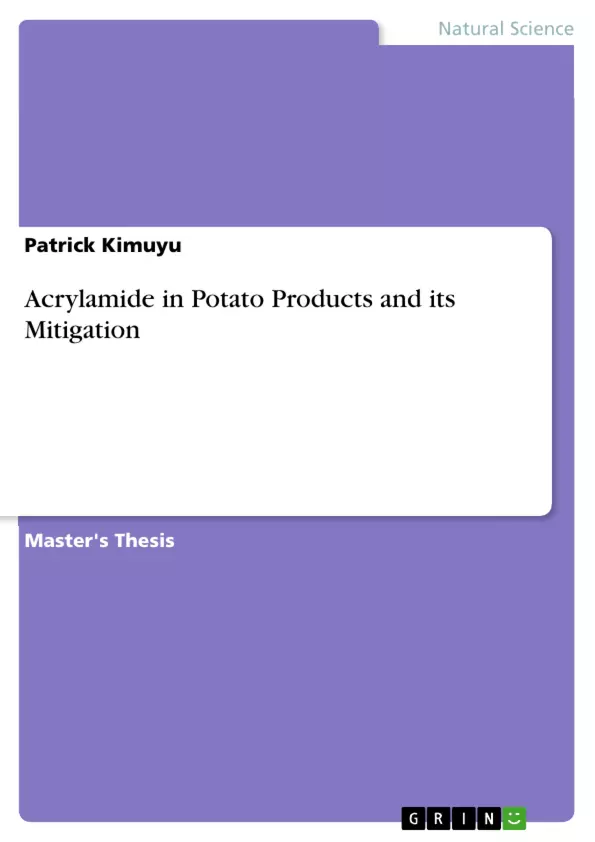Acrylamide has been found to be a biodegradable compound that exhibits high mobility in groundwater and soil. These characteristics are attributable to its physical and chemical characteristics including its high solubility in water and organic solvents such as ethanol and acetone. Clinical studies indicate that acrylamide forms glycidamide as the principal metabolite in animals. In humans, acrylamide and glycidamide are known to form adducts with most proteins including glutathione, and they are eliminated from the body through the renal system which serves as the primary route of acrylamide excretion.
In the past decade, acrylamide has attracted immense attention from food agencies after it was found to be formed naturally in most carbohydrate-rich foods; thus, raising health concerns. The results obtained from epidemiological studies show that dietary acrylamide causes toxicity, and it is a potent carcinogen. Therefore, mitigation approaches have been designed including the reduction of acrylamide precursors in potatoes and controlling processing conditions.
Inhaltsverzeichnis (Table of Contents)
- 1.0 INTRODUCTION.
- 2.0 LITERATURE REVIEW
- 2.1 Historical Overview
- 2.2 Acrylamide Formation in Foods.
- 2.2.1 Major Acrylamide Formation Pathway.
- 2.2.2 Minor Acrylamide Formation Pathway.
- 2.3 Potential Acrylamide Precursors in Foodstuffs..
- 2.4 Range of Products Associated with Acrylamide..
- 2.5 Effects of Acrylamide Consumption
- 2.6 Acrylamide in Potatoes.
- 2.6.1 Formation of Acrylamide in Potatoes
- 2.6.2 Acrylamide Levels in Potato Products...........
- 2.7 Aspects Affecting Acrylamide Formation in Fried Potato Products..
- 3.0 ACRYLAMIDE REGULATIONS
- 3.1 International Regulations
- 3.2 EU Regulations.
- 3.3 Acceptable Acrylamide Levels in Saudi Arabia and the EU.
- 3.4 ACRYLAMIDE RISK MANAGEMENT
- 3.4.1 Evolution of Acrylamide Risk Management......
- 3.5 ACRYLAMIDE RISK ASSESSMENT.
- 3.5.1 Hazard Identification....
- 3.5.2 Hazard Characterization......
- 3.6 EXPOSURE ASSESSMENT.
- 3.6.1 Methods Used To Assess Human Dietary Acrylamide Intake.
- 3.6.1.1 Food Frequency Questionnaire (FFQ) Method..
- 3.6.1.2 Databases.
- 3.6.1 Methods Used To Assess Human Dietary Acrylamide Intake.
- 3.7 ACRYLAMIDE MITIGATION IN POTATO PRODUCTS
- 3.7.1 Acrylamide Mitigation Methods.
- 3.7.1.1 Biological methods for Acrylamide mitigation in Potato products..
- 3.7.1.2 Physical methods for Acrylamide Mitigation in Potato Product.......
- 3.7.1.3 Chemical Methods for Acrylamide Reduction in Potato Products
- 3.8 Industry and Consumer Based Guidelines ....
- 3.8.1 WHO/FAO acrylamide reduction Guidelines
- 3.8.2 US Draft Industry Guidelines...........
- 3.8.3 EU Guidelines on Acrylamide Reduction
- 3.8.4 Saudi Arabia mitigation Approaches.......
- 3.7.1 Acrylamide Mitigation Methods.
- 4.1 CONCLUSION.
- 4.2 Recommendations
Zielsetzung und Themenschwerpunkte (Objectives and Key Themes)
This work aims to provide a comprehensive overview of acrylamide, a potentially carcinogenic compound found in various food products, particularly potato products. The research explores its formation, levels, effects, and mitigation strategies. The main objectives include:- To review the historical background and formation pathways of acrylamide in food.
- To evaluate the health effects and potential risks associated with acrylamide consumption.
- To analyze the existing regulations and mitigation strategies for reducing acrylamide levels in food products.
- To assess the current knowledge and research gaps related to acrylamide in potatoes and its impact on human health.
- To discuss the potential benefits and challenges of implementing various acrylamide mitigation approaches in food production and processing.
Zusammenfassung der Kapitel (Chapter Summaries)
This section provides a brief overview of the main themes and arguments presented in each chapter of the research. **Chapter 1: Introduction:** This chapter sets the stage for the research by introducing the topic of acrylamide, highlighting its significance as a potential health hazard, and outlining the objectives and scope of the study. **Chapter 2: Literature Review:** This chapter delves into the existing literature on acrylamide, providing a comprehensive overview of its formation, pathways, levels, effects, and mitigation strategies. It explores the role of different food types, processing conditions, and other factors that influence acrylamide formation. The chapter also examines the available data on acrylamide levels in various food products, particularly potatoes and potato products. **Chapter 3: Acrylamide Regulations:** This chapter focuses on the current regulatory framework for acrylamide in various regions, including international, European Union (EU), and Saudi Arabian regulations. It analyzes the acceptable levels of acrylamide in different food products and explores the evolution and implementation of acrylamide risk management strategies. **Chapter 4: Acrylamide Risk Management:** This chapter examines the various risk management approaches employed to address acrylamide concerns, including hazard identification, characterization, exposure assessment, and mitigation strategies. It discusses the methods used to evaluate human exposure to acrylamide through dietary intake and explores the effectiveness of different mitigation techniques in reducing acrylamide levels in food products. **Chapter 5: Acrylamide Mitigation in Potato Products:** This chapter specifically focuses on acrylamide mitigation strategies for potato products, exploring various methods like biological, physical, and chemical approaches. It discusses the potential benefits and limitations of each method and analyzes the effectiveness of current industry and consumer-based guidelines for reducing acrylamide levels in potato products.Schlüsselwörter (Keywords)
The primary focus of this research revolves around acrylamide, its formation, levels, and mitigation in food products, especially potatoes. The work delves into the chemical and biological aspects of acrylamide formation, analyzes its health implications, and investigates the effectiveness of different mitigation approaches. Key themes include: acrylamide, food safety, human health, potato products, mitigation strategies, risk assessment, regulation, exposure assessment, dietary intake, and processing conditions.
- Quote paper
- Patrick Kimuyu (Author), 2017, Acrylamide in Potato Products and its Mitigation, Munich, GRIN Verlag, https://www.grin.com/document/380385



